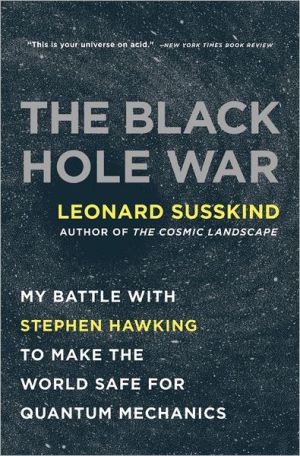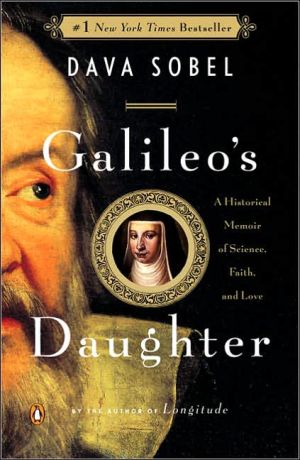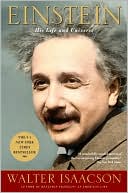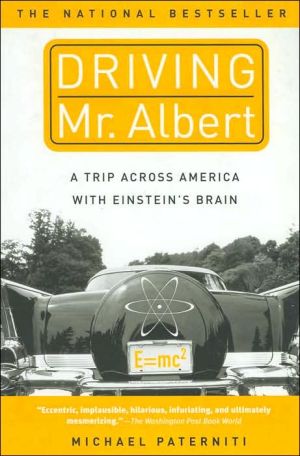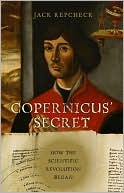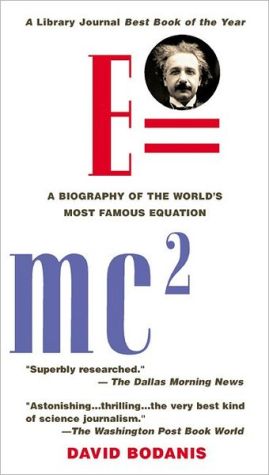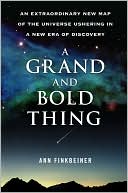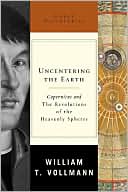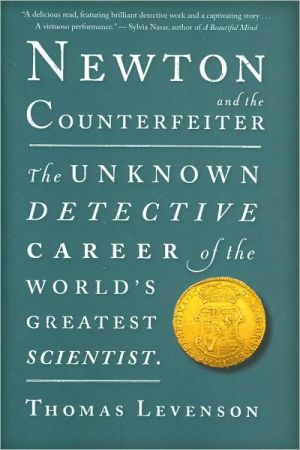The Black Hole War: My Battle with Stephen Hawking to Make the World Safe for Quantum Mechanics
At the beginning of the 21st century, physics is being driven to very unfamiliar territory—the domain of the incredibly small and the incredibly heavy. The new world is a world in which both quantum mechanics and gravity are equally important. But mysteries remain. One of the biggest involved black holes. Famed physicist Stephen Hawking claimed that anything sucked in a black hole was lost forever. For three decades, Leonard Susskind and Hawking clashed over the answer to this problem....
Search in google:
At the beginning of the 21st century, physics is being driven to very unfamiliar territory—the domain of the incredibly small and the incredibly heavy. The new world is a world in which both quantum mechanics and gravity are equally important. But mysteries remain. One of the biggest involved black holes. Famed physicist Stephen Hawking claimed that anything sucked in a black hole was lost forever. For three decades, Leonard Susskind and Hawking clashed over the answer to this problem. Finally, in 2004, Hawking conceded. THE BLACK HOLE WAR will explain the mind-blowing science that finally won out, and the emergence of a new paradigm that argues the world—this catalog, your home, your breakfast, you—is actually a hologram projected from the edges of space. The Barnes & Noble Review In ancient Greece, aspirants to the Elusinian Mysteries, seeking to partake of godlike knowledge into the workings of the cosmos, had to undergo the rigors of travel, fasting, ingestion of mind-altering substances, ritual chanting and dramatics, and a climactic orgy. Nowadays, those selfsame seekers have it easy, needing merely to purchase one of the many available mind-blowing books of popular science and dive into theophany-inducing explanations of reality's screwball quantum substrate. A vivid and fascinating case in point is Leonard Susskind's The Black Hole War, freshly available in paperback after its well-received 2008 hardcover debut. At the core of this stimulating volume is an arcane but easily statable controversy of nearly 30 years' duration: is information (in the technical, Shannonesque sense) utterly and forever destroyed by black-hole ingestion? This simple yet deep question, full of dramatic implications for all of physics, involves everything from string theory to brane theory to holographic models of the cosmos, all of which, plus much more, is laid out in Baedecker-lush detail by Susskind, whose window-pane prose and Holmesian logic foster epiphanies in the reader in nearly every chapter. Susskind is no dispassionate journalist but rather an insider and participant in this "war." Facing a mighty antagonist in the form of Stephen Hawking, Susskind chronicles their intellectual battles with zest and not a little arrogance of the victor (for the current consensus on the topic favors Susskind's camp). His ultimate description of Hawking as a tragic figure of diminished abilities, finally forced to concede defeat, should forever dispel the stereotype of scientists as ice-water-veined brainiacs. But Susskind never allows the emotional components of the battle to cloud his delivery of the facts and theories. He arrays the cliffhanger developments of three decades, along with just the right amount of backstory, in the deft manner of a novelist, proving himself a born storyteller whose unconventional troupe of players just happens to consist of gluons and photons against a scrim of Anti de Sitter Space. --Paul DiFilippo
The Black Hole War My Battle with Stephen Hawking to Make the World Safe for Quantum Mechanics \ \ By Leonard Susskind Little, Brown \ Copyright © 2008 Leonard Susskind\ All right reserved.\ ISBN: 978-0-316-01640-7 \ \ \ Chapter One THE FIRST SHOT \ San Francisco, 1983\ The dark clouds of war had been gathering for more than eighty years by the time the initial skirmish took place in the attic of Jack Rosenberg's San Francisco mansion. Jack, also known as Werner Erhard, was a guru, a supersalesman, and a bit of a con man. Prior to the early 1970s, he had been just plain Jack Rosenberg, encyclopedia salesman. Then one day, while crossing the Golden Gate Bridge, he had an epiphany. He would save the world and, while he was at it, make a huge fortune. All he needed was a classier name and a new pitch. His new name would be Werner (for Werner Heisenberg) Erhard (for the German statesman Ludwig Erhard); the new pitch would be Erhard Seminars Training, aka EST. And he did succeed, if not in saving the world, at least in making his fortune. Thousands of shy, insecure people paid several hundred dollars each to be harangued, harassed, and (according to legend) told that they couldn't go to the toilet during the sixteen-hour motivational seminars run by Werner or one of his many disciples. It was a lot cheaper and faster than psychotherapy, and in a way it was effective. Shy and uncertain going in, the attendees appeared confident, strong, and friendly-justlike Werner-coming out. Never mind that they sometimes seemed like manic, hand-shaking robots. They felt better. "The training" was even the subject of a very funny movie called Semi-Tough with Burt Reynolds.\ EST groupies surrounded Werner. Slaves would definitely be too strong a term; let's call them volunteers. There were EST-trained chefs to cook his food, chauffeurs to drive him around town, and all manner of house servants to staff his mansion. But ironically, Werner himself was a groupie-a physics groupie.\ I liked Werner. He was smart, interesting, and fun. And he was fascinated by physics. He wanted to be part of it, so he spent wads of money bringing groups of elite theoretical physicists to his mansion. Sometimes just a few of his special physics buddies-Sidney Coleman, David Finkelstein, Dick Feynman, and I-would meet in his home for spectacular dinners catered by celebrity chefs. But more to the point, Werner liked to host small, elite conferences. With a well-equipped seminar room in the attic, a staff of volunteers to cater to our every whim, and San Francisco as the venue, the mini-conferences were lots of fun. Some physicists were suspicious of Werner. They thought he would use the physics connection in some devious way to promote himself, but he never did. As far as I can tell, he just liked hearing about the latest ideas from the characters who were hatching them.\ I think there were three or four EST conferences altogether, but only one left an indelible imprint on me, and on my physics research. The year was 1983. The guests included, among other notables, Murray Gell-Mann, Sheldon Glashow, Frank Wilczek, Savas Dimopoulos, and Dave Finkelstein. But for this story, the most important participants were the three main combatants in the Black Hole War: Gerard't Hooft, Stephen Hawking, and myself.\ Although I had met Gerard only a few times before 1983, he had made a big impression on me. Everyone knew that he was brilliant, but I sensed much more than that. He seemed to have a steel core, an intellectual toughness that exceeded that of anyone else I knew, with the possible exception of Dick Feynman. Both of them were showmen. Dick was an American showman-brash, irreverent, and full of macho one-upmanship. Once, among a group of young physicists at Cal Tech, he described a joke that the graduate students had played on him. There was a sandwich place in Pasadena where they served "celebrity" sandwiches. You could get a Humphrey Bogart, a Marilyn Monroe, and so on. The students had taken him to lunch there-I think for his birthday-and one after another ordered the Feynman sandwich. They had conspired with the manager beforehand, and the guy behind the counter didn't bat an eye.\ After he finished the story, I said, "Gee, Dick, I wonder what the difference would be between a Feynman sandwich and a Susskind sandwich."\ "Oh, they'd be about the same," he replied, "except the Susskind sandwich would have more ham."\ "Yeah," I responded, "but a lot less baloney." That was probably the only time I beat him at that game.\ Gerard is a Dutchman. The Dutch are the tallest people in Europe, but Gerard is short and solidly built, with a mustache and the look of a burgher. Like Feynman, 't Hooft has a strong competitive streak, but I am sure that I never got the better of him. Unlike Feynman, he is a product of old Europe-the last great European physicist, inheritor of the mantle of Einstein and Bohr. Although he is six years younger than I am, I was in awe of him in 1983, and rightfully so. In 1999 he was awarded the Nobel Prize for his work leading to the Standard Model of elementary particles.\ But it wasn't Gerard whom I most remember from Werner's attic. It was Stephen Hawking, whom I first met there. It's where Stephen dropped the bomb that set the Black Hole War in motion.\ Stephen is also a showman. He is a physically tiny man-I doubt that he weighs a hundred pounds-but his small body contains a prodigious intellect and an equally outsized ego. At that time, Stephen was in a more or less ordinary powered wheelchair, and he could still talk using his own voice, though he was very hard to understand unless you spent a lot of time with him. He traveled with an entourage that included a nurse and a young colleague who would listen to him very carefully and then repeat what he said.\ In 1983 his translator was Martin Rocek, now a well-known physicist and one of the pioneers in an important subject called Supergravity. At the time of the EST conference, however, Martin was quite young and not so well known. Nevertheless, from previous meetings I knew that he was a very capable theoretical physicist. At some point in our conversation, Stephen (through Martin) said something that I thought was wrong. I turned to Martin and asked him for clarification of the physics. He looked at me like a deer caught in the headlights. Later he told me what had happened. It seems that translating Stephen's speech required such intense concentration that he was usually unable to keep track of the conversation. He barely knew what we were talking about.\ Stephen is an unusual sight. I am not talking about his wheelchair or the obvious physical limitations of his body. Despite the immobility of his facial muscles, his faint smile is unique, simultaneously angelic and devilish, projecting a sense of secret amusement. During the EST conference, I found talking to Stephen very difficult. It took a long time for him to answer, and his answers were usually very brief. These short, sometimes single-word answers, his smile, and his almost disembodied intellect were unnerving. It was like communicating with the Oracle at Delphi. When someone submitted a question to Stephen, the initial response was absolute silence, and the eventual output was often incomprehensible. But the knowing smile said, "may not understand what I'm saying, but I do, and I am right."\ The world sees the diminutive Stephen as a mighty man, a hero of extraordinary courage and fortitude. Those who know him see other sides: Stephen the Playful and Stephen the Bold. One evening during the EST conference, a few of us were out walking on one of San Francisco's famous brake-busting hills. Stephen was with us, driving his powered chair. When we reached the steepest section, he turned on the devilish smile. Without a moment's hesitation, he took off down the hill at maximum velocity, the rest of us startled. We chased him, fearing the worst. When we got to the bottom, we found him sitting and smiling. He wanted to know whether there was a steeper hill to try. Stephen Hawking: the Evel Knievel of physics.\ Indeed, Hawking is very much a daredevil of a physicist. But perhaps his boldest move ever was the bomb he dropped in Werner's attic.\ I can't remember how his lecture worked at EST. Today a physics seminar given by Stephen has him sitting quietly in his chair while a disembodied computer voice lectures from a previous recording. That computerized voice has become Stephen's trademark; as flat as it is, it is full of personality and humor. But back then, maybe he talked and Martin translated. However it happened, the bomb fell with full force on Gerard and me.\ Stephen claimed that "information is lost in black hole evaporation," and, worse, he seemed to prove it. If that was true, Gerard and I realized, the foundations of our subject were destroyed. How did the rest of the people in Werner's attic receive the news? Like the coyote in the roadrunner cartoon who overruns the edge of the cliff: the ground had disappeared beneath their feet, but they didn't know it yet.\ It is said of cosmologists that they are often in error but never in doubt. If so, Stephen is only half a cosmologist: never in doubt but hardly ever wrong. In this case, he was. But Stephen's "mistake" was one of the most seminal in the history of physics and could ultimately lead to a profound paradigm shift about the nature of space, time, and matter.\ Stephen's lecture was the last that day. For about an hour afterward, Gerard stood glaring at the diagram on Werner's blackboard. Everyone else had left. I can still see the intense frown on Gerard's face and the amused smile on Stephen's. Almost nothing was said. It was an electric moment.\ On the blackboard was a Penrose diagram, a type of diagram representing a black hole. The horizon (the edge of the black hole) was drawn as a dashed line, and the singularity at the center of the black hole was an ominous-looking jagged line. Lines pointing inward through the horizon represented bits of information falling past the horizon into the singularity. There were no lines coming back out. According to Stephen, those bits were irretrievably lost. To make matters worse, Stephen had proved that black holes eventually evaporate and disappear, leaving no trace of what has fallen in.\ Stephen's theory went even further. He postulated that the vacuum-empty space-was full of "virtual" black holes that flashed into and out of existence so rapidly that we didn't notice them. The effect of these virtual black holes, he claimed, was to erase information, even if there was no "real" black hole in the vicinity.\ In chapter 7, you will learn exactly what "information" means and also what it means to lose it. For now, just take it from me: this was an unmitigated disaster. 'T Hooft and I knew it, but the response from everyone else who heard about it that day was "Ho hum, information is lost in black holes." Stephen himself was sanguine. For me the toughest part of dealing with Stephen has always been the irritation I feel at his complacency. Information loss was something that just could not be right, but Stephen couldn't see it.\ The conference broke up, and we all went home. For Stephen and Gerard, that meant back to Cambridge University and the University of Utrecht, respectively; for me a forty-minute drive south on Route 101 back to Palo Alto and Stanford University. It was hard to concentrate on the traffic. It was a cold day in January, and every time I stopped or slowed down, I would draw the figure from Werner's blackboard on my frosty windshield.\ Back at Stanford, I told my friend Tom Banks about Stephen's claim. Tom and I thought about it intensely. To try to learn some more, I even invited one of Stephen's former students to come up from Southern California. We were very suspicious of Stephen's claim, but for a while we weren't sure why. What's so bad about losing a bit of information inside a black hole? Then it dawned on us. Losing information is the same as generating entropy. And generating entropy means generating heat. The virtual black holes that Stephen had so blithely postulated would create heat in empty space. Together with another colleague, Michael Peskin, we made an estimate based on Stephen's theory. We found that if Stephen was right, empty space would heat up to a thousand billion billion billion degrees in a tiny fraction of a second. Although I knew that Stephen was wrong, I couldn't find the hole in his reasoning. Perhaps that was what irritated me the most.\ The ensuing Black Hole War was more than an argument between physicists. It was also a war of ideas, or perhaps a war between fundamental principles. The principles of Quantum Mechanics and those of General Relativity always seemed to be fighting each other, and it was not clear that the two could coexist. Hawking is a general relativist who had put his trust in Einstein's Equivalence Principle. 'T Hooft and I are quantum physicists who felt certain that the laws of Quantum Mechanics could not be violated without destroying the foundations of physics. In the next three chapters, I will set the stage for the Black Hole War by explaining the basics of black holes, General Relativity, and Quantum Mechanics.\ (Continues...)\ \ \ \ \ Excerpted from The Black Hole War by Leonard Susskind\ Copyright © 2008 by Leonard Susskind. Excerpted by permission.\ All rights reserved. No part of this excerpt may be reproduced or reprinted without permission in writing from the publisher.\ Excerpts are provided by Dial-A-Book Inc. solely for the personal use of visitors to this web site. \ \
Introduction 3Part I The Gathering Storm1 The First Shot 172 The Dark Star 253 Not Your Grandfather's Geometry 504 "Einstein, Don't Tell God What to Do" 765 Planck Invents a Better Yardstick 1116 In a Broadway Bar 1177 Energy and Entropy 1268 Wheeler's Boys, or How Much Information Can You Stuff in a Black Hole? 1439 Black Light 157Part II Surprise Attack10 How Stephen Lost His Bits and Didn't Know Where to Find Them 17911 The Dutch Resistance 19312 Who Cares? 20013 Stalemate 21114 Skirmish at Aspen 225Part III Counterattack15 The Battle of Santa Barbara 23316 Wait! Reverse the Rewiring 26517 Ahab in Cambridge 27118 The World as a Hologram 290Part IV Closing the Ring19 Weapon of Mass Deduction 30920 Alice's Airplane, or The Last Visible Propeller 35421 Counting Black Holes 36622 South America Wins the War 39523 Nuclear Physics? You're Kidding! 42224 Humility 433Epilogue 442Acknowledgments 449Glossary 451Index 457
\ James TrefilThe Black Hole Wars is as good an introduction as you're going to find to the strange world of black hole astrophysics. Add that to the chance to ride along as real scientists resolve a fundamental issue and you have the makings of a great read.\ —The Washington Post\ \ \ \ \ Publishers WeeklyBets made over a beer between scientists rarely make the headlines, but in 2004 Stephen Hawking conceded that he'd lost a bet and that a view he had held for 30 years was wrong. According to Stanford physicist Susskind (The Cosmic Landscape), one of the leaders of the anti-Hawking camp, the argument was a simple one: if information falls into a black hole, is it lost forever? Hawking's theory that information is destroyed undermined everything scientists thought they knew about quantum physics. Susskind gives readers a course in black holes, quantum physics and string theory as he explains his belief that information cannot be destroyed. Along the way he introduces bizarre theories like the Holographic Principle (which he helped develop), claiming that the third dimension is an illusion and that energy and matter are just forms of information. Susskind also profiles two hot-shot South American physicists who helped deliver the coup de grace to Hawking's argument. Black hole and Hawking fans should go for this book, even if the great physicist was wrong. B&w illus. (July 7)\ Copyright © Reed Business Information, a division of Reed Elsevier Inc. All rights reserved.\ \ \ Library JournalBeyond the flamboyant title and subtitle, this book presents an interesting view of today's physics as it moves into ever more abstract areas. Writing for the general public, Susskind (The Cosmic Landscape: String Theory and the Illusion of Intelligent Design), a distinguished Stanford University theorist, uses a relaxed and often humorous style of presentation. He is candid in admitting that string theory, which is at the heart of the newest physics, lacks experimental proof. Nevertheless, string theory and other approaches have succeeded in convincing nearly everybody that information is not lost via black hole radiation. The author's informal style certainly makes his book more digestible for nonspecialists, but at times he wanders so far afield that the discussion thread is lost. Tighter editing could have made the book shorter and more understandable. Recommended for college and large public libraries.\ —Jack W. Weigel\ \ \ \ \ \ The Barnes & Noble ReviewIn ancient Greece, aspirants to the Elusinian Mysteries, seeking to partake of godlike knowledge into the workings of the cosmos, had to undergo the rigors of travel, fasting, ingestion of mind-altering substances, ritual chanting and dramatics, and a climactic orgy. Nowadays, those selfsame seekers have it easy, needing merely to purchase one of the many available mind-blowing books of popular science and dive into theophany-inducing explanations of reality's screwball quantum substrate. \ A vivid and fascinating case in point is Leonard Susskind's The Black Hole War, freshly available in paperback after its well-received 2008 hardcover debut.\ At the core of this stimulating volume is an arcane but easily statable controversy of nearly 30 years' duration: is information (in the technical, Shannonesque sense) utterly and forever destroyed by black-hole ingestion? This simple yet deep question, full of dramatic implications for all of physics, involves everything from string theory to brane theory to holographic models of the cosmos, all of which, plus much more, is laid out in Baedecker-lush detail by Susskind, whose window-pane prose and Holmesian logic foster epiphanies in the reader in nearly every chapter.\ Susskind is no dispassionate journalist but rather an insider and participant in this "war." Facing a mighty antagonist in the form of Stephen Hawking, Susskind chronicles their intellectual battles with zest and not a little arrogance of the victor (for the current consensus on the topic favors Susskind's camp). His ultimate description of Hawking as a tragic figure of diminished abilities, finally forced to concede defeat, should forever dispel the stereotype of scientists as ice-water-veined brainiacs.\ But Susskind never allows the emotional components of the battle to cloud his delivery of the facts and theories. He arrays the cliffhanger developments of three decades, along with just the right amount of backstory, in the deft manner of a novelist, proving himself a born storyteller whose unconventional troupe of players just happens to consist of gluons and photons against a scrim of Anti de Sitter Space. --Paul DiFilippo\ \ \
